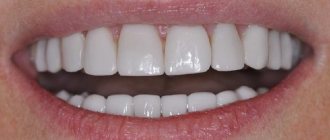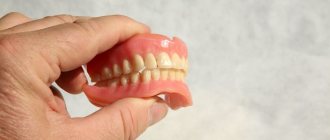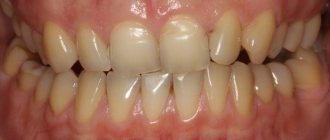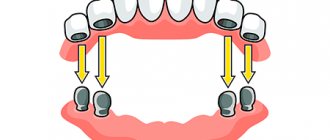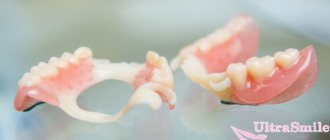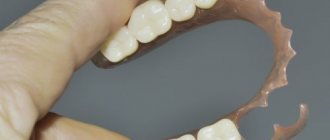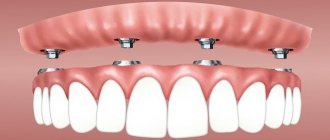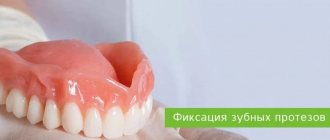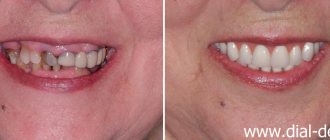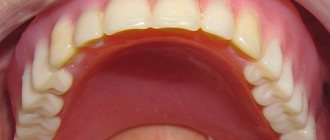Partial removable dentures are a simple and affordable denture option when one or more teeth are missing. They allow you to quickly restore aesthetics and functionality without surgical intervention. Within a week you will receive “new teeth”.
At our Center, partial dentures are manufactured in our own digital dental laboratory. The use of advanced materials, modern orthopedic protocols and the latest technologies allows us to create comfortable removable dentures that look as natural as possible and are a worthy alternative to implants.
Removable dentures - an affordable alternative to implantation
A partial removable denture is an orthopedic structure in the form of an artificial gum (base) with teeth attached to it and fastening elements for fixation on the natural teeth remaining in the mouth. Depending on the type of structure, the base can be made entirely of plastic or have a metal frame inside.
Modern removable dentures are a reliable and convenient way to restore missing teeth
Regarding removable dentures, there are many prejudices in society about their inconvenience, massiveness, falling out of the mouth under load, the need to take them off at night and put them in a cup. Modern dentures have nothing in common with their predecessors. If they are made “conscientiously”, they provide a high cosmetic effect, are securely fixed in the mouth, and make it possible to eat almost any food without fear.
Removable dentures are somewhat inferior to fixed structures on implants or bridges in terms of the degree of fixation and adaptation, and require special hygienic care. But sometimes this is the only way to restore teeth when:
- contraindications for implantation
- absence of outer teeth in a row
- patient's personal beliefs
- preparation for implantation, as a temporary option
Prices
Free online consultation with a dentist
| Service | Price |
| Installation of a temporary cosmetic plate (butterfly) | from 11,000 rub. |
| Installation of a complete or partially removable lamellar denture (acrylic, 1 jaw) | from 32,000 rub. |
| Installation of a partially removable nylon prosthesis (1 jaw) | from 40,000 rub. |
| Installation of a clasp denture with clasps (1 jaw) | from 40,000 rub. |
| Installation of a complete removable denture Akri Free (1 jaw) | from 47,000 rub. |
| Installation of a one-stage multi-unit implant with screw fixation (Switzerland, Trate AG) with an adaptation crown | from 50,000 rub. |
| Installation of a splinting clasp prosthesis (1 jaw) | from 55,000 rub. |
| Installation of a partially removable clasp prosthesis Quadrotti (1 jaw) | from 64,500 rub. |
| Installation of a locking clasp prosthesis (1 jaw) | from 70,000 rub. |
| Installation of a clasp denture on telescopic crowns (1 jaw) | from 75,000 rub. |
| Conditionally removable acrylic prosthesis on spherical attachments Rhein-83 for 1 jaw | from 121,000 rub. |
| Installation of a complete metal-plastic bridge prosthesis on one-stage implants of the ROOTT system (alloy Germany, plastic Japan - 1 jaw), cement fixation | from 130,000 rub. |
| Installation of a complete metal-plastic bridge prosthesis on one-stage implants of the ROOTT multi-unit system with screw fixation (Germany alloy, on a metal frame, Japan plastic - 1 jaw) | from 155,000 rub. |
| Installation of a complete metal-plastic bridge prosthesis on one-stage implants of the ROOTT multi-unit system with screw fixation (Germany alloy, on a titanium frame, Japan plastic - 1 jaw) | from 175,000 rub. |
| Installation of a full bridge ceramic-composite prosthesis on one-stage implants (Germany alloy, on a metal frame, Japan composite - 1 jaw) with cement fixation | from 230,000 rub. |
| Installation of a complete metal-ceramic bridge prosthesis on one-stage implants of the ROOTT system on a metal frame, 1 jaw, cemented fixation | from 210,000 rub. from 250,000 rub. promotion |
| Installation of a full bridge ceramic-composite prosthesis on one-stage implants (Germany alloy, on a titanium frame, Japan composite - 1 jaw) with cement fixation | from 250,000 rub. |
| Installation of a complete metal-ceramic bridge prosthesis on one-stage implants of the ROOTT multi-unit system with screw fixation, 1 jaw, metal frame | from 230,000 rub. from 270,000 rub. promotion |
| Installation of a complete bridge made of zirconium dioxide on one-stage implants of the ROOTT system, 1 jaw, cemented fixation | from 320,000 rub. |
| Installation of a complete PREMIUM ceramic-composite bridge prosthesis on one-stage implants of the ROOTT multi-unit system with screw fixation on a titanium frame CONDYLAR - stage II | from 320,000 rub. |
| Installation of a complete bridge made of zirconium dioxide on one-stage implants of the ROOTT multi-unit system with screw fixation, 1 jaw | from 370,000 rub. |
| Installation of a full bridge ceramic-composite prosthesis on one-stage implants of the ROOTT system on a reinforced titanium milling frame with a stump for each tooth of increased aesthetics on cement fixation, 1 jaw, stage II (SHOFU ceramic composite, Japan) | from 400,000 rub. |
| Installation of a full bridge ceramic-composite prosthesis on one-stage implants of the ROOTT system on a reinforced titanium milling frame with a stump for each tooth of increased aesthetics on a screw fixation, 1 jaw, stage II (SHOFU ceramic composite, Japan) | from 420,000 rub. |
| Installation of a full ceramic bridge on one-stage implants of the ROOTT multi-unit system with screw fixation with individual IMAX crowns on a reinforced PREMIUM titanium milling frame, 1 jaw, stage II | from 480,000 rub. |
Consultation and diagnostics are free!
All prices Promotions
Sign up for a consultation
three ROOTT specialists + diagnostics as a gift
Advantages
Partial dentures are a quick and affordable way to restore teeth without surgery.
- Cost They are much cheaper than implantation and do not require expensive surgical procedures or osteoplastic surgery.
- Speed: Production takes 1-2 weeks. For implantation with preparation, bone grafting and engraftment of implants - at least 4 months.
- Convenient When properly made from high-quality materials, taking into account the bite after adaptation, it feels like your own teeth in the mouth.
- Aesthetics Improved materials and modern orthopedic protocols make it possible to create prosthetics that are indistinguishable from natural teeth.
When using removable prosthetics, it is extremely important that the prosthesis is made not “by eye,” but taking into account the characteristics of the patient’s dentofacial apparatus. Otherwise, it is impossible to obtain a comfortable denture with the correct distribution of chewing load. This is fraught with constant inconvenience, gum injuries, rapid destruction of supporting teeth, the formation of a pathological bite, and dysfunction of the jaw joint.
Chashchin Kirill Valerievich
Orthopedic dentist, 14 years of experience
Digital prosthetics. Aesthetic restorations with veneers with a lifetime guarantee. Total orthopedic rehabilitation in one day
More about the doctor
Types of removable dentures for partial absence of teeth
Removable partial dentures differ in design and manufacturing materials - depending on the number of missing teeth and the location of the defect in the dentition.
Lamellar
The basis of the design is a plastic plate that exactly repeats the anatomy of the gum. Fixation in the mouth is carried out using clasps (hooks) that cling to the teeth adjacent to the defect. To improve the aesthetics of the prosthesis, the fastening elements can be made of the same material as the artificial gum.
Depending on the base material, plate dentures are:
- Acrylic - made of acrylic plastic, durable, aesthetic, and the most affordable. If the dental technician follows technological protocols and uses high-quality materials, acrylic dentures do not cause allergic reactions. Service life - up to 5 years.
- Nylon - made of soft plastic material, aesthetic, but impractical, not suitable for long-term use due to deformation of the base under chewing loads. The optimal wearing period is up to 1 year.
- Acry-Free - made of non-monomer elastic plastic, less rigid than acrylic and not as soft as nylon, have less weight and volume and are therefore more comfortable. They are securely fixed to the gums and look natural in the mouth. Service life - 5-7 years.
Clasp
With a metal frame at the base, which is lined with an acrylic or nylon base with artificial teeth. This type of construction gives the prosthesis additional strength and rigidity, while at the same time allowing to significantly reduce its size and make it more comfortable. Clasp dentures are securely fixed, completely restore chewing function, provide a high cosmetic effect, last 10 years, and with proper care longer.
Attached using:
- Hooks (clasps) are the simplest type of fastening and do not imply pre-treatment of the supporting teeth. The prosthesis is fixed to them using hooks that may be visible.
- Locks (attachments) - the supporting teeth are covered with special crowns (therefore their preparation is required), into which one part of the fastening mechanism is mounted, and the second part is located in the prosthesis. When putting on the prosthesis, the fastening elements snap into place. Compared to the previous version, the locking mount is more reliable and aesthetic, and the prosthesis is more functional.
- Telescopic system - involves the installation of primary telescopic crowns made of metal or zirconium on the supporting teeth. They connect to secondary ones, which are part of the prosthesis. This fixation option is more expensive, but the prosthesis lasts longer. In order to make such a structure, the high skill of a dental technician and the availability of special equipment are required.
Immediate dentures
Temporary removable dentures for 1-2 teeth made of acrylic or nylon. They are attached to the teeth adjacent to the defect using hooks. In terms of functionality, they are very limited, so they are not suitable for long-term use. They are installed immediately after tooth extraction in an aesthetically significant area to hide the defect and prevent neighboring teeth from moving into the resulting void.
a clasp prosthesis as a permanent prosthesis.
It is more compact than the plate type, uses a smaller area of the gums and palate, and is securely fixed to the supporting teeth, forming a single system with them. The fastening features make the prosthesis as invisible as possible in the mouth and extend its service life.
Levin Dmitry Valerievich Chief physician and founder of the Doctor Levin center
Implant-supported dentures
This type of structure is fundamentally different from all those described above in that they are fixed to implants implanted into the bone of the upper jaw , which consist of a bioinert titanium alloy with a special coating. The implants themselves, after installation and engraftment, are motionless and not visible in the oral cavity. Special parts - abutments - are attached to their upper part, and the denture will be installed using two types of fixation - cement or screw.
Such designs make it possible to replace both single defects and complete edentia. In the second case, for the upper jaw the minimum number of installed implants is 4. Reliance on implants has a number of undoubted advantages: very high aesthetics, absence of bone tissue atrophy, complete immobility, durability, reliability and ease of use and care of such prostheses. It is worth noting that if replacement is necessary, the implant remains unchanged and can serve to support a different type of structure.
Differences between the upper and lower jaw
When partial removable prosthetics is used for the teeth of the upper and lower rows, the anatomical features of the jaws and the type of structure being installed are taken into account.
- On the lower jaw Fixation is carried out by attaching it to the supporting teeth using one of the available methods (hooks, locks, telescopic crowns) and resting on the gums. In laminar dentures, support is provided by a massive base, in clasp dentures - a thin metal arch located in the sublingual zone.
- For the upper jaw For reliable fixation, the prosthesis is additionally equipped with a palatal overlap - a wide plastic one in plate designs or a narrow metal arch in clasp ones. In terms of convenience, the clasp prosthesis wins, since it uses a much smaller area of the palate.
Computer diagnostics - for reliable data
The Center uses a GALILEOS tomograph (The Dental Company SIRONA, Germany)
- Assessment of the condition and size of bone tissue to select the material and height of the prosthesis base
- Study of the position and functions of the temporomandibular joint
- Analysis of the condition of abutment teeth
Stages of prosthetics
Creating a comfortable removable denture that exactly matches the patient’s dental system requires several visits to the clinic. It will be necessary to take at least three pairs of impressions, carry out at least three fittings and practice the bite.
- Diagnostics Examination of the oral cavity, computed tomography to assess the condition of supporting teeth, bone tissue, and the type of prosthesis is determined.
- Preparation of teeth Treatment of supporting teeth is carried out if necessary, preparation for prosthetics, depending on the type of fixation of the structure.
- Taking impressions Impressions of the jaws are taken (digital with an intraoral scanner or using impression mass) to make a model of the prosthesis.
- Determination of occlusion Using the facebow, central occlusion is determined and fixed. Based on the data obtained, the artificial teeth are placed on a wax model in the articulator.
- Fittings A series of preliminary fittings of the wax model are carried out until the upper and lower jaws meet perfectly. The wax is then replaced with plastic in the laboratory. The finished prosthesis is polished and ground.
- Installation The bite is fixed with the prosthesis installed in the mouth, and the correct relationship of the jaws is again checked on the articulator. If the slightest inaccuracies are detected, the design is corrected.
The final fixation of the prosthesis is carried out taking into account the type of fastening used. Adaptation usually takes 1-2 weeks. To make the adjustment period pass quickly and comfortably for the patient, the specialist may prescribe additional adjustments. Our goal is to perfect the denture so that it feels like your own teeth in your mouth .
What is chewing efficiency
As you know, the oral cavity is also the beginning of the digestive tract. After preliminary thorough grinding, food enters the stomach through the esophagus. Therefore, a very important factor in healthy digestion is the concept of chewing efficiency - this is the work that is actually performed by the chewing apparatus, of which the teeth are an integral part. A loss of 40% of chewing efficiency is the limit that leads to digestive disorders and is an absolute indication for prosthetics.
